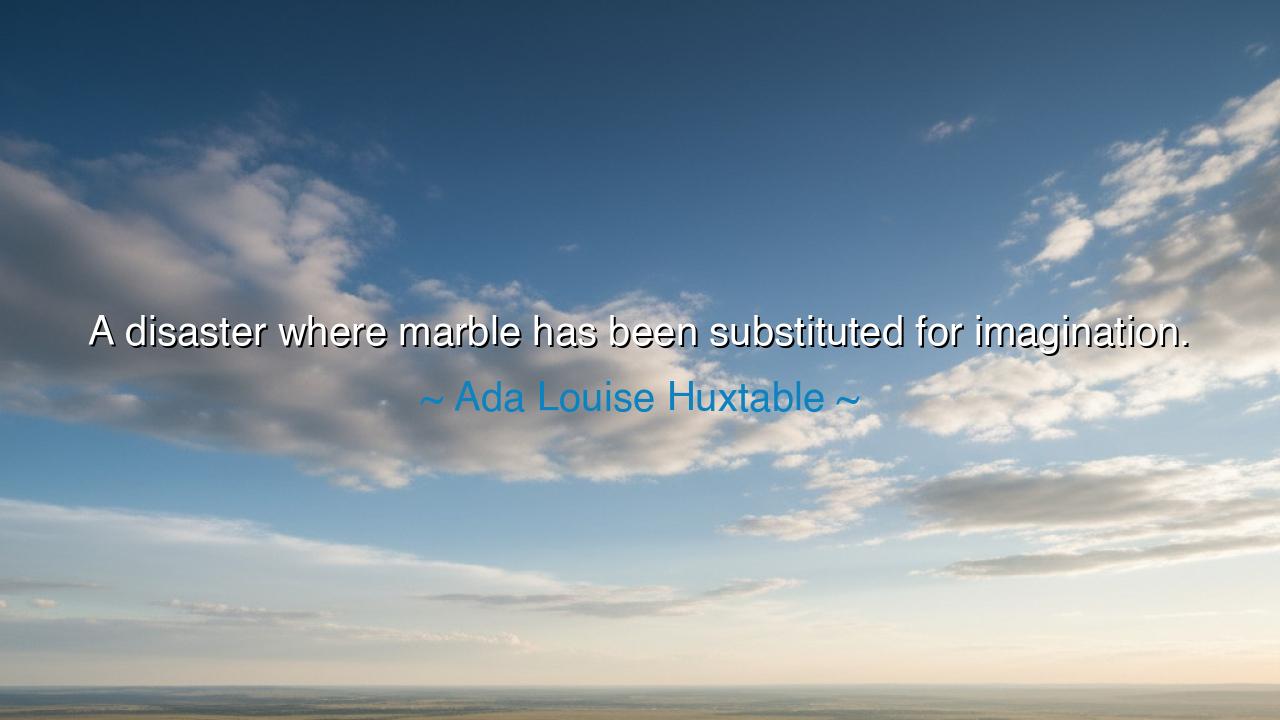
A disaster where marble has been substituted for imagination.






“A disaster where marble has been substituted for imagination,” spoke Ada Louise Huxtable, the fierce voice of architectural conscience. In these few words lies a lament for all ages — not only for the builders of stone, but for all who build in spirit. Huxtable, critic and seer of cities, saw a world where form triumphed over soul, where glittering monuments rose high yet hollow, like idols made of fine gold but lacking the breath of the divine. Her cry was not against marble itself — for marble, when animated by vision, can sing — but against the death that follows when imagination is abandoned for display, when the substance of thought is traded for the shadow of beauty.
In her time, Huxtable walked among the rising towers of the twentieth century — the age of steel and spectacle. She saw cities clothed in glass and stone, yet bereft of spirit, as if humanity, drunk on its own power, had forgotten that buildings are meant to elevate the soul, not merely to announce wealth. Her words recall the wisdom of the ancients, who knew that the temple was holy not because of its marble, but because of what dwelt within. The disaster she names is not of architecture alone, but of civilization itself — the moment when appearance devours meaning, when we build without wonder, and decorate without purpose.
Think of Ancient Rome in her final splendor. The emperors built vast palaces, their pillars tall as forests, their domes painted with gods they no longer believed in. The marble gleamed brighter than ever before, but the fire of the republic had long gone cold. The Pantheon, though magnificent, became but a shell for the glory of a dying age. Bread and circuses replaced vision; artistry was replaced by ornament. Rome fell not when its stones cracked, but when its imagination grew silent. This is the disaster Huxtable warns of — a ruin not of the body, but of the creative spirit.
And yet, across time, there have always been those who remembered. The sculptor Michelangelo, when asked how he created his David, said, “I saw the angel in the marble and carved until I set him free.” In that saying lies the antidote to the disaster. For Michelangelo did not worship marble — he served imagination. The stone was his servant, not his master. When imagination reigns, even humble clay becomes divine; but when imagination is exiled, even the finest marble becomes a tomb. The true artist, the true thinker, must therefore labor not to decorate the world, but to reveal its hidden light.
We too live in an age of glittering surfaces — of towers that touch the sky, of machines that promise everything, of images that dazzle and vanish in the same breath. The danger is the same: that we mistake grandeur for greatness, wealth for worth, beauty for vision. The marble of our time may not be stone, but technology, luxury, or fame — the materials with which we attempt to build meaning without imagination. But such structures, no matter how shining, crumble in the winds of time.
Thus, dear listener, learn the wisdom that form without spirit is emptiness, and wealth without vision is decay. In all your works — whether you build, write, love, or dream — do not seek marble first; seek imagination. Let your creations spring from the inner world before they take shape in the outer one. Ask yourself not, “How grand will it appear?” but “Does it breathe truth?” For only imagination can endow your labor with life that endures.
The lesson is eternal: do not build monuments, build meaning. Let imagination be the cornerstone of your craft, your home, your life. If you must carve in marble, carve as Michelangelo did — to release, not to impress. Let your work, however humble, carry the breath of vision. For in the end, marble crumbles, but imagination endures beyond the grave of time. When the marble turns to dust, the dream remains — bright, living, and eternal in the hearts of those yet unborn.






AAdministratorAdministrator
Welcome, honored guests. Please leave a comment, we will respond soon